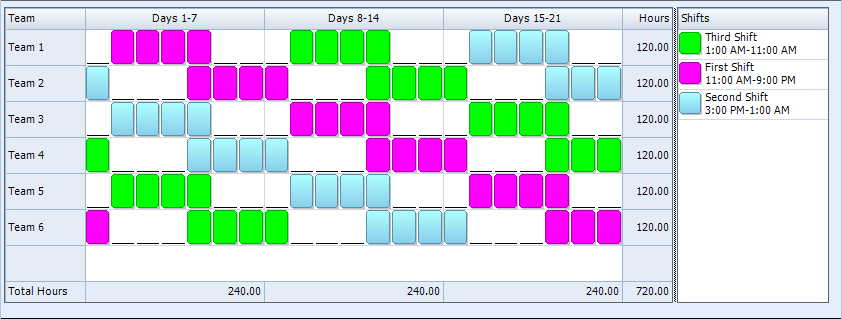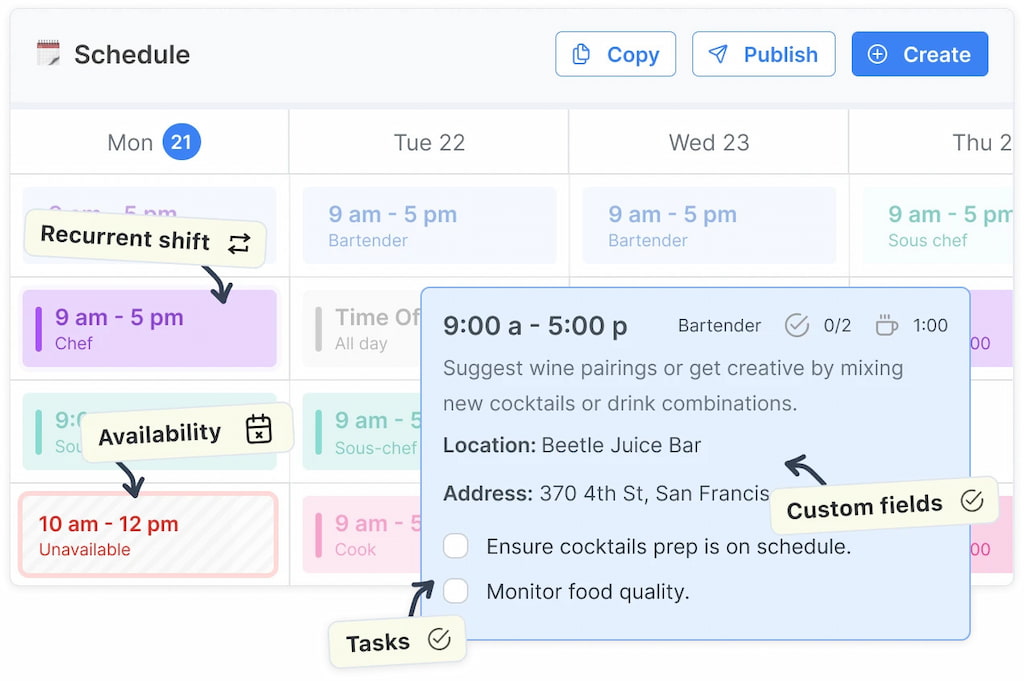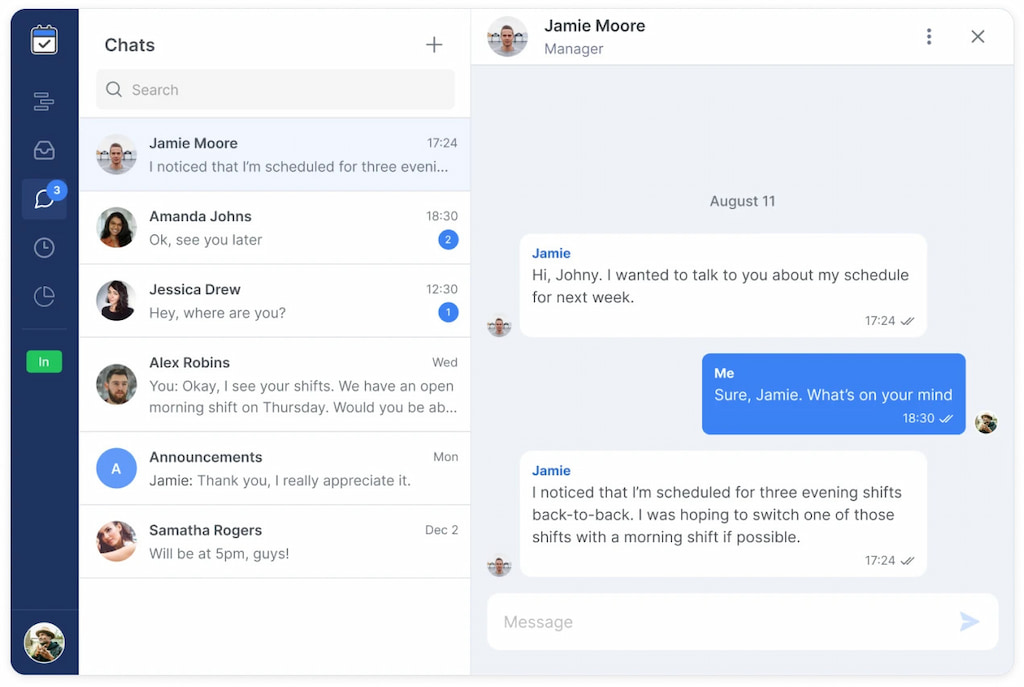The idea of working four 10‑hour days—often called a 4 × 10 schedule or 4/10 shift schedule—has seen renewed interest as companies explore flexible work options. But what exactly is a 4 10 work week, and is it a good fit for crews in construction, field service, manufacturing, or other industries with demanding projects and tight deadlines? This guide demystifies the 4 ten‑hour shifts schedule and provides real‑world insights for operations leaders (as well as best service industry scheduling software).
🌟 Why the 4/10 Schedule Is Trending
During Great Resignation, employees began demanding better work–life balance. Surveys found:
- 80% of workers support a 4/10 schedule
- 1 in 3 employees say they’d stay longer at a company if offered one
- In trials of 4-day workweeks, companies saw:
- 63% reporting easier hiring and retention
- 8% overall revenue growth (37% compared to the previous year)
- 78% of employees feeling happier and less stressed
👉 Gen Z workers even said they’d need a major pay raise to return to a five-day work week.
This shift isn’t just for offices. Construction crews, utilities, and field service teams are also testing compressed schedules to improve morale and cut turnover. But here’s where confusion creeps in:
- Compressed 4-day week → 32 hours, same pay
- 4/10 schedule → Four 10-hour days, still 40 hours total
This guide clears up the difference and shows how to put a 4/10 schedule into practice.
📅 What Is a 4/10 Shift Schedule?
A 4/10 shift schedule means employees work four days per week, each day lasting 10 hours, for a standard 40-hour workweek.
It’s also called a 4 × 10 schedule, a 4 tens schedule, or a 4 10-hour days schedule.
Unlike flexible or part-time setups, a 4/10 schedule keeps a full-time workload—it’s just compressed into fewer days. In most cases, that means Monday–Thursday with Fridays off, creating a built-in 3-day weekend.

❓ How it differs from a four-day workweek
A lot of “4-day week” headlines actually refer to 32-hour schedules where employees work fewer hours for the same pay. That requires big changes in responsibilities.
By contrast, a 4/10 schedule:
- Keeps the 40-hour total
- Simply spreads it across four longer days
🌟 Key distinctions
- Hours worked: 40 hours with a 4/10 vs. 32 hours in a true four-day week
- Overtime: In some states, working beyond 8 hours in a day may trigger daily overtime
- Coverage: Managers must ensure staff are available on the “off” day so operations don’t suffer
⚖️ Pros and Cons of Working 4 10‑Hour Days
When considering a 4/10 shift schedule, leaders need to weigh both the advantages and the challenges. Here’s a breakdown with real-world crew-based examples.
✅ Advantages of 4/10 schedules
- Longer project time blocks → Construction crews can finish tasks without stopping mid-shift, and field techs can service more customers in one trip.
- 3-day weekends → Employees get extra rest or personal time, boosting morale and retention—especially in hard-to-fill roles like equipment operators.
- Higher productivity → Fewer start/stop cycles mean more focused work on big projects like HVAC installs or concrete pours.
- Lower absenteeism → A predictable 4-on/3-off rhythm means workers take fewer sick days and appointments fit better outside work.
- Customer-friendly hours → Longer shifts allow service outside 9–5, e.g., landscapers handling irrigation jobs from 7 a.m. to 5 p.m.
⚠️ Challenges of 4/10 schedules
- Fatigue & safety risks → Ten-hour physical shifts can push workers to exhaustion, raising accident risks with heavy equipment.
- Harder to cover absences → Replacing a missed 10-hour shift is tougher than an 8-hour one, often leading to costly overtime.
- Less flexibility → Parents, caregivers, or part-time staff may struggle with longer days.
- Overtime costs → In some states/contracts, any hours beyond 8 per day trigger overtime pay.
- Coverage gaps → If everyone takes Friday off, urgent calls may go unanswered. Staggered schedules solve this, but add complexity.

🔄 Comparing 4/10 Schedules With Other Work Patterns
Before adopting a 4×10 shift schedule, it helps to see how it stacks up against other common models.
🕘 9/80 schedule
- Employees work eight 9-hour days and one 8-hour day over two weeks.
- They earn an extra day off every other week.
- Pros: Shorter daily hours than 4/10, still offers extended weekends.
- Cons: Varying day lengths make scheduling more complex.
⏰ Flexible schedules & split shifts
- Workers choose a flexible schedule or a shift split into two smaller shifts.
- Ideal for employees with caregiving duties or school pickups.
- Example: A field tech works a morning shift, handles personal obligations midday, then returns for evening jobs.
- Pro: Boosts recruitment and retention across industries.
🔁 Rotating schedules
- Examples: 2-2-3 (Pitman schedule) or 3-2 patterns.
- In a 2-2-3 model: two days on, two off, three on, then repeat.
- Pros: Ensures 24/7 coverage.
- Cons: Disruptive to personal life; adapting to night shifts can be tough.
- Common in: Healthcare, emergency services, and other continuous operations.
📉 Compressed four-day week (32 hours)
- Workers put in 32 hours across 4 days.
- Studies show boosts in productivity and satisfaction.
- Pro: More rest, higher morale.
- Con: Not always feasible for roles needing a fixed number of service calls or billable hours.
🛠️ How to Implement a 4/10 Schedule Successfully
Adopting a 4×10 shift schedule isn’t just about telling crews to work four days a week. It takes planning, communication, and the right tools. Here are the key steps:
✅ 1. Assess suitability
- Check workflow and demand. Make sure there’s enough work to fill 10-hour days without long downtime.
- Review labor laws and contracts. Some states require daily overtime beyond 8 hours; unions may have limits.
- Get employee input. Survey staff on preferences and personal constraints. A short trial run can highlight issues early.
📅 2. Design the rotation and coverage plan
- Stagger off days. Example: Group A works Mon–Thu, Group B Tue–Fri, so coverage continues all week.
- Plan for emergencies. Assign backup or on-call staff and outline compensation policies.
- Balance skills daily. Ensure each shift has the right mix (e.g., equipment operators, certified flaggers).
💻 3. Use scheduling software to manage complexity
Manual scheduling in spreadsheets quickly becomes unwieldy when dealing with 10‑hour days, multiple teams, and staggered off days. Shifts by Everhour is a modern scheduling solution that can simplify 4/10 rotations. It allows managers to:
- Assign shifts easily and visually. Create 10‑hour blocks and drag them onto a calendar. Shifts’ color‑coded timeline helps ensure coverage and avoid overlaps.

- Track time and attendance. Workers can clock in/out via mobile app or kiosk. Attendance data ties back to payroll and overtime calculations, addressing overtime concerns.
- Manage time‑off requests. If an employee requests a day off, Shifts by Everhour shows potential scheduling conflicts and identifies coverage gaps.
- Communicate with crews. Built‑in chat features keep everyone informed about schedule changes. Teams can confirm assignments, swap shifts, or request coverage right within the app.

By using scheduling software designed for crew scheduling, managers reduce errors and labour costs while empowering employees with visibility and flexibility.
🔄 4. Pilot & adjust
- Test the schedule for 2–3 months.
- Track productivity, overtime, customer satisfaction, and employee feedback.
- Adjust shift lengths, start times, or rotation patterns as needed.
- Example: Shorten to 9 hours if fatigue rises, or add more staff midweek when demand peaks.
By taking a structured approach, companies can roll out a 4/10 schedule smoothly—boosting morale while maintaining coverage.
📖 Case Study: Field Service Company Adopts a 4/10 Schedule
This fictional example shows how a midsize HVAC maintenance company made the shift to a 4×10 schedule and overcame challenges.
🏢 Company Background
BetterAir Services employs 45 technicians serving commercial HVAC systems across a metro area. Their typical day meant eight hours of service calls plus travel. Customers wanted early morning or evening appointments, but the company struggled to cover outside a 9–5 window. Technician turnover was high, especially among younger workers looking for a better balance.
⚠️ Challenge
Management explored a 4/10 schedule to give techs a three-day weekend while expanding service hours. Concerns included potential burnout from longer days and coverage gaps on Fridays.
💡 Solution
BetterAir tested the schedule for three months using Shifts by Everhour. They set up two teams:
- Team A: Mon–Thu, 7 a.m.–5 p.m.
- Team B: Tue–Fri, 8 a.m.–6 p.m.
The software lets them assign jobs, monitor overtime, and coordinate coverage. Techs clocked in on mobile, managers tracked time-off requests, and push notifications reminded crews about shifts and directions.
📊 Results
- Higher technician satisfaction: Techs liked the extra day off for personal needs. Morale rose and turnover dropped.
- Expanded service window: Customers welcomed early and late appointments, boosting revenue by 12% during the trial.
- Manageable fatigue: With breaks and safety checks, no burnout issues arose. The software flagged excessive hours.
- Reduced overtime cost: Real-time monitoring cut unauthorized overtime, lowering labor costs by 7%.
Given the results, BetterAir adopted the 4/10 schedule permanently, adjusting start times seasonally and continuing to rely on Shifts by Everhour for scheduling and communication.
❓ Addressing Common Questions and Objections
Are 4 × 10 schedules better than five 8‑hour days?
It depends on the work and staff preferences. For continuous operations, 4/10 reduces inefficiencies from starting and stopping. For physically demanding or precise tasks, longer shifts may increase errors.
How do you manage overtime in a 4/10 schedule?
Overtime laws differ by state. In California, hours over 8 per day trigger overtime pay. Use scheduling software to track hours, avoid unplanned overtime, and consider splitting tasks across teams to stay compliant.
Will longer shifts decrease productivity due to fatigue?
Productivity can remain steady with adequate breaks and manageable workloads. Encourage hydration and rest, and for heavy labor, some organizations split 10‑hour shifts into two 5‑hour blocks with a long break in between.

What if my clients or job sites require support five days a week?
Stagger teams so at least one group works each weekday. This ensures coverage while still giving staff a three‑day weekend at some point in the cycle.
How do 4 ten‑hour shifts compare to the 2‑2‑3 schedule?
The 2‑2‑3 (Pitman) schedule cycles two days on, two off, three on, two off. It provides recovery days but rotates day and night shifts, making it more complex than 4/10. The 4/10 schedule is simpler for daytime or extended-hour operations.
⚙️ Choosing a Shift Model: Factors to Consider
When deciding on a 4/10 schedule or other shift patterns, keep these points in mind:
- Nature of the work – Can tasks be completed in 10-hour blocks, or is 24-hour coverage required? Repetitive or physically demanding work may need shorter shifts.
- Demand peaks – Schedule around high-demand days or times to ensure coverage.
- Employee preferences – Not everyone prefers long shifts. Survey staff or have one-on-one discussions to accommodate needs.
- Safety and health – Longer days require adequate breaks, hydration, and fatigue management strategies.
- Regulatory environment – Review local labor laws and union agreements regarding overtime and rest periods.
- Technology readiness – Use tools like Shifts by Everhour to plan, track, and adjust shifts efficiently, including time-off requests, overtime alerts, and team communication.
💻 Why Software Is Essential for Managing 4/10 Schedules
Managing a 4/10 schedule manually can cause double bookings, missed assignments, and confusion over who’s off when. The right software makes it easier to stay organized.
- Automatic conflict detection and overtime alerts – Real-time tools show potential overlaps or overtime thresholds before shifts are published, preventing errors and compliance issues.
- Centralized communication – Built-in chat and notifications keep crews informed about assignments, location changes, or emergency coverage. Teams always know where to be and when.
- Employee self-service and empowerment – Allowing workers to request or swap shifts reduces administrative work and improves satisfaction. Surveys show many employees value control over their schedules.
- Compliance and certification tracking – In regulated industries, software ensures only qualified staff are assigned to certain tasks, reducing risk and improving quality.
- Reporting and analytics – Shift patterns, overtime, absenteeism, and project completion data help managers optimize staffing and resource allocation.
⚠️ Pitfalls and Troubleshooting Tips
Even with careful planning, challenges can emerge when adopting a 4 × 10 schedule. Here’s how to anticipate and handle issues.
Managing fatigue and preventing burnout
- Schedule rest periods: Include mid-shift breaks (e.g., two 15-minute breaks and a 30-minute meal). For intensive tasks, consider shorter, more frequent rests.
- Rotate tasks: Alternate between heavy and lighter duties to reduce strain, like switching between digging trenches and operating equipment.
- Provide wellness resources: Offer hydration stations, encourage stretching, and educate on sleep hygiene.

Handling emergencies and last‑minute changes
- On-call backup: Assign a technician to cover unexpected absences and provide incentives for on-call shifts.
- Real-time updates: Use mobile apps like Shifts by Everhour to send shift change notifications instantly and require acknowledgment.
Communicating with clients about schedule changes
- Set expectations: Inform clients about your new operating hours. Provide alternative contact methods for emergencies on days when their usual technicians are off.
- Use dispatch notes: Include notes in the scheduling software about client preferences or special instructions. Share relevant details with the assigned crew member.
Incorporating part‑time or seasonal workers
Offer flexible 4-, 6-, or 8-hour shifts on certain days to accommodate availability. Scheduling software can overlay part-time and full-time shifts to ensure coverage without overburdening anyone.
📄 Crafting a Policy: Sample Guidelines
Companies adopting a 4 10 work schedule should document policies to ensure consistency and compliance. Below is a sample outline for creating a shift policy.
- 📝 Purpose: Explain why the 4/10 schedule is being implemented (e.g., improve work–life balance, extend service hours, boost retention).
- 🏢 Scope: Define which departments or positions are eligible. For example, field technicians and installation crews may follow 4/10, while customer support keeps standard hours.
- 📅 Scheduling cycle: Specify the start and end of the workweek (e.g., Monday–Thursday for Team A) and explain how coverage is handled on off days.
- 💵 Overtime and pay: Clarify overtime rules, including daily thresholds. Include pay rates for on-call or emergency work.
- 🎉 Time off and holidays: Describe how vacation, sick leave, and holidays interact with the 4/10 schedule. For example, if a holiday falls on an employee’s day off, will they get an alternate day?
- ⏱️ Safety and breaks: Outline required breaks and maximum consecutive hours. Reference OSHA or local regulations as needed.
- 🔄 Evaluation and feedback: Commit to periodic reviews, invite employee input, and adjust schedules based on feedback.
🌐 Real‑World User Insights: Reddit and Community Voices
To gauge worker sentiment about the 4/10 schedule, we looked at community forums. Key takeaways:
- 👷 Morale boost: Many workers love the extra day off. A construction supervisor on Reddit shared: “We switched to 4/10s and it was great for morale, but we had to watch for burnout in summer when temperatures hit 100+ degrees.”
- 🚗 Better commute & personal time: Another worker noted, “Traffic’s lighter when we start at 6 a.m., and I love having Fridays free to see my kids’ school events.”
- ⚖️ Need for flexibility: These anecdotes highlight the importance of seasonal and individual adjustments.
From management’s side:
- 📉 Potential productivity dips: Some worry quality may decline in the final hours of long shifts.
- ✅ Tools and clear expectations help: Teams using proper scheduling software and clear guidelines maintain output and quality.
Key takeaway: There’s no one-size-fits-all solution. Start with a pilot program and gather continuous feedback.
⚠️ When a 4/10 Schedule May Not Be Right
Despite its appeal, a 4/10 work schedule isn’t ideal for every organization. Scenarios where it may not fit include:
- 🏥 24/7 operations requiring multiple shifts: Hospitals, emergency response teams, or similar industries may benefit more from rotating schedules like 2‑2‑3.
- 📉 Highly seasonal or fluctuating demand: If workloads vary unpredictably, consistent 10‑hour shifts can cause idle time or force overtime.
- ⏱️ Part‑time heavy workforce: When many employees work fewer than 40 hours weekly, 10‑hour shifts may create conflicts.
- 📜 Regulatory restrictions: Maximum daily hours, mandatory breaks, or union rules may limit the feasibility of long shifts.
✅ Final Thoughts and Next Steps
The 4/10 shift schedule offers clear benefits: extended weekends, improved morale, and longer uninterrupted work blocks. However, challenges like fatigue, potential overtime, and coverage gaps remain. Success hinges on careful planning, continuous feedback, and the right technology.
- 🛠️ Leverage software: Shifts by Everhour helps design and manage 4‑day schedules efficiently. Map 10‑hour shifts, stagger days off, track time, monitor overtime, and communicate changes instantly.
- 📊 Pilot and evaluate: Test a 4/10 schedule on a small scale. Gather feedback, track performance, and adjust as needed.
- 🌟 Optimize and retain: With thoughtful implementation, a 4/10 schedule can reduce turnover, boost productivity, and make your organization more competitive.
💡 Tip: Consider giving Shifts by Everhour a test run—real-time scheduling and crew communication can make shift planning easier and help your team work smarter, not harder.

